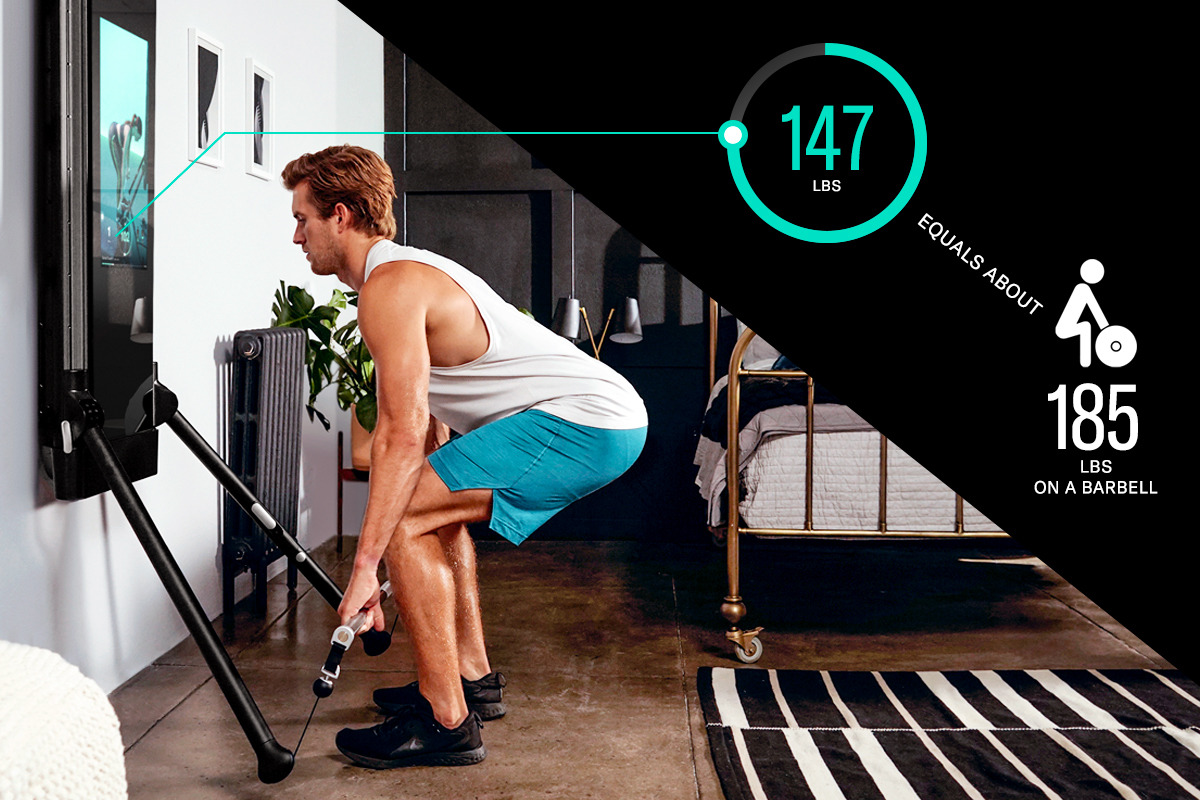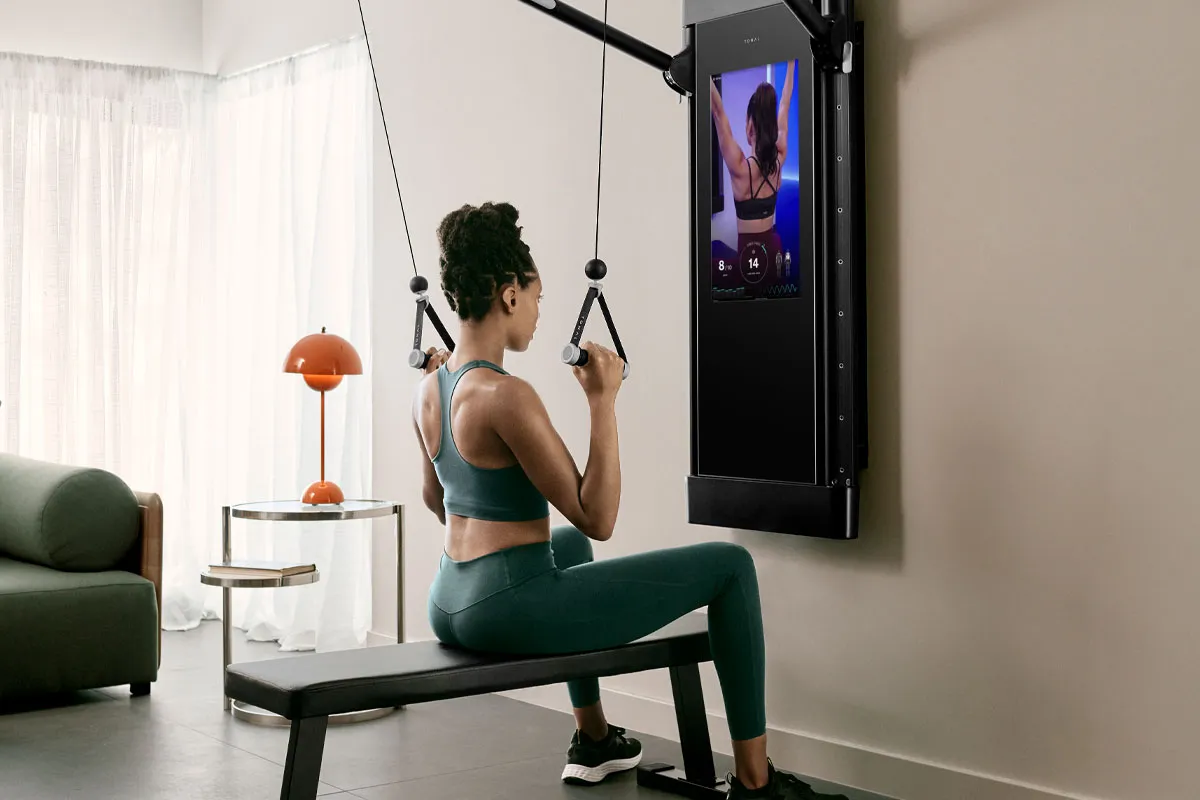Advanced lifters Stipe Miocic, Paul Sklar, and Michelle Tee weigh in on whether 200 pounds of digital resistance is enough to feel challenged.
Updated October 22, 2024.

Paul Sklar is a 25-year fitness veteran with muscles carved like an action figure. Take just a few seconds to scroll through his Instagram, and you’ll know right away that the former pro duathlete can move big weight.
Is he an advanced lifter? Yes. Is 200 pounds of resistance enough for a guy as jacked as Sklar? Yes.
“I am going to show you the difference between digital weight, and regular weight…” he said in a review of Tonal on YouTube, “and I guarantee you, you are going to be blown away by digital weight.”
Is digital weight the same as traditional weight? The answer: not exactly. It does feel different. In fact, it feels around 22 percent heavier than dumbbells or traditional cable machines according to an independent study conducted out of High Point University. But Tonal’s member data also reveals only 4 percent of Tonal members have maxed out the weight for one rep and even fewer max out regularly.
Two hundred pounds of resistance is plenty for most athletes for most movements. Here, advanced lifters like Sklar, Stipe Miocic, a former MMA world champion, and Michelle Tee, a Tonal community member, share their experiences with compound exercises like deadlifts and squats using digital weight.
Paul Sklar: The only way to actually experience what this feels like, is to actually get on it.
In Sklar’s review, he tested biceps curls on Tonal, and compared that to a traditional biceps curl with regular weights. He mentions his favorite mode on Tonal is Eccentric mode, and goes onto explain that, “In traditional lifting, the strongest part of your lift occurs during the eccentric phase where your muscle is stretching and contracting at the same time.”
Sklar describes the comparison of Tonal and regular weights, explaining, “So if I am using a regular dumbbell, I can’t change the weight on the way down, and I can’t change the weight on the way up. Tonal changes everything for me. So on the concentric phase where I can lift less weight, it lightens the weight for me and then I can choose how much weight I want to add to the eccentric phase. If I want to add 20 pounds on the way down, I can, and then it will adjust right back to my regular weight for the concentric phase. So I get much more work, I get more muscle fiber recruitment, and the end result is better.”
Sklar explained that he had never used digital weight before trying Tonal, and said transparently, “I am always skeptical about workout equipment because new things are coming out constantly. I am not a technology guy—I am a pretty basic guy when it comes to lifting. But when I actually got on [Tonal] and I did a high cable flight, I thought to myself, ‘Holy you know what! That was phenomenal!’ I went from skeptic to fan very, very quickly.”
In the video, Sklar also highlighted how Tonal’s digital weight allows for other dynamic weight modes like Spotter (a feature that automatically reduces the weight and offers an assist when you’re tapped). “Spotter mode will make sure you get through every exercise with no problem.”

Stipe Miocic: Two hundred pounds of digital weight is heavier than you think it is.
As a mixed martial artist and father of two small children, Miocic realized the potential of having a total-body strength training system at home for his workouts. The heavyweight champion said he “wasn’t skeptical about Tonal, and definitely wanted to try it.”
Like many athletes, Miocic was completely taken aback by the resistance the first time he trained on Tonal. “It’s an amazing machine. The 200 pounds of resistance is a lot heavier than you think it is,” said Miocic. “The first time I [used] it, I was nowhere near the top of the resistance and very sore the next day.”
Using free weights and dumbbells allow for utilizing momentum that helps you through your reps. Digital weight, however, is powered by a premium electric motor which provides minimal momentum, resulting in consistent, constant resistance for an entire rep. This additional time under tension (the duration muscles are held under strain during an exercise which leads to increased strength and results) makes for a more effective workout, but it’s also the reason why heavy lifters find that 200 pounds of digital weight is more than enough to feel challenged.
For Miocic, digital weight has another added advantage: His home is now safer for his kids without free weights. “Having two children, one that’s three and one that’s a newborn but eventually is going to start walking [too], I didn’t want to have a lot of free weights laying around.”
Read About the Science: New Study Shows Tonal’s Weight Feels Up to 23 Percent Heavier Than You’d Expect
Michelle Tee: Consider the other benefits and versatility of lifting with digital weight.
Tee, a Tonal member renowned for lifting heavy and sharing creative Custom Workouts on Tonal to Instagram, admitted that her “main concern in the beginning was the resistance was not enough.” After training on Tonal, however, she came to the conclusion that “in actuality, 200 pounds of digital weight is plenty.”
Tee quickly learned that there’s a big difference between traditional weight and Tonal’s resistance, “20 pounds of digital weight does not equal 20 pounds of free weight…it doesn’t feel the same,” she said. Tee also noted she can no longer rely on inertia or momentum of free weights to aid her lifts, “all of that is eliminated with digital weight,” which makes strength training more challenging at lighter weights.
As someone who has fretted over whether 200 pounds is enough, her advice to heavy lifters is not to focus solely on the resistance, and consider the other benefits and versatility of lifting with Tonal. “It takes up no space; you can move through exercises seamlessly; and [unlike] some machines in the gym, you can use the adjustable arms to tailor every move to your body’s requirements,” she said.
Tee explained that for experienced lifters, the main benefit of Tonal is how you can use digital weight to push yourself by taking advantage of dynamic weight modes like Eccentric and Smart Flex. Tee likes Eccentric because this feature adds additional weight to the rep, optimizing time under tension further, and letting her burn each muscle group out. She also calls Smart Flex, a feature that can automatically detect where you are strongest in a lift and add more weight at that exact moment, a game-changer.
Pro Training Tips For Heavy Lifters on Tonal
The data shows that only 4 percent of Tonal members have ever maxed out the weight for one rep. But, if you still think there’s a chance you will hit the ceiling on resistance, there are several ways to train with digital weight to make the most of the 200 pounds of resistance Tonal offers. Here, Max Artsis, Tonal Sport Performance Specialist, shares a few tools he leverages with pro-athletes and sports teams training on Tonal.
- Slow It Down
Training with a slower tempo makes the eccentric portion of a lift more challenging by increasing time under tension. “Even five pounds can feel very heavy if you hold it up for 10 minutes,” Artsis says. “If you’re normally doing a movement in one to two seconds during the eccentric portion, try expanding that to three to four seconds. It’s a very easy way to make the weight feel heavier.”
Remember, digital weight gives you consistent resistance for both the concentric (shortening) and eccentric (lengthening) phases of the rep. Research suggests that spending more time in the eccentric portion (loading the muscle while it’s in a stretched or lengthened position), not only improves hypertrophy, but it also puts the most strain on the muscle fibers when compared with concentric and isometric, and thus equals more strength gains.
- Try Unilateral Lower-Body Movements
Heavy lifters concerned about maxing out on lower body exercises should also consider unilateral training like single-leg deadlifts, for example. Artsis said 80 percent of his lower-body training is now unilateral. “When you remove half of your base of support, you quickly notice where you are strong and where you are weakest.”
In addition to exposing imbalances masked by the body’s ability to compensate, training unilaterally allows for greater stimulation, Artsis added. “Most people will get all the physiological response they need out of lifting as heavy as they can on one limb,” he said.
- Increase Range of Motion
You can also increase your range of motion to gain extra depth on lower body movements. Artsis suggests doing goblet squats or deadlifts on a block or step so you are elevated and the weight starts on the ground. “Increasing the range of motion makes it tougher because the cable has to travel further before it racks on the arm.”



